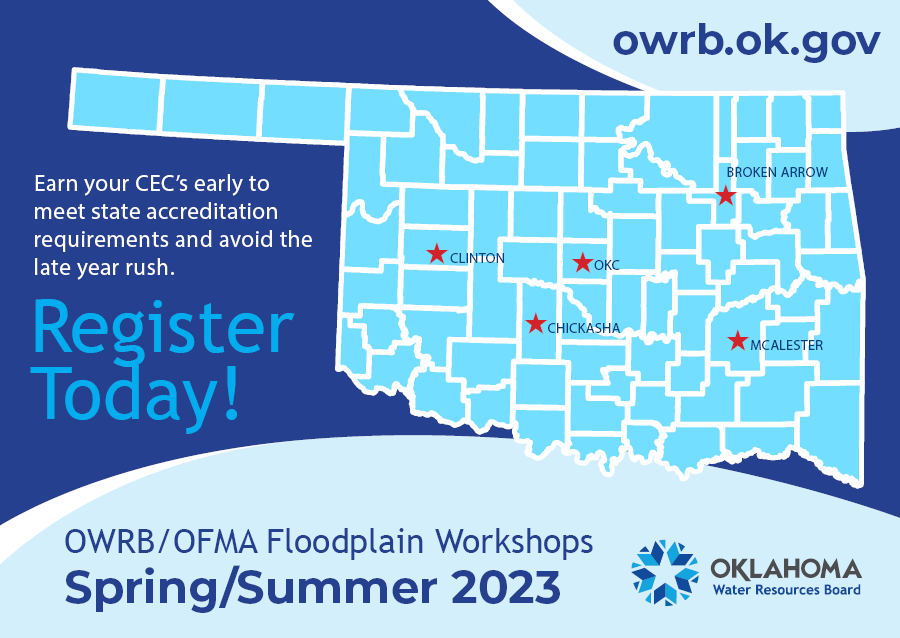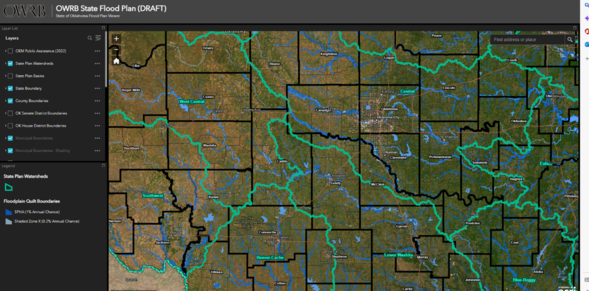|
As we near the half-way point of the OWRB’s FY 23 FPA accreditation calendar, the floodplain management team would like to thank the hundreds of FPAs, officials, and citizens who took their time to attend a course in 2022. We very much enjoy meeting the stakeholders we serve statewide.
At owrb.ok.gov/floodplain/calendar you’ll find the new training calendar featuring a variety of events offered by OWRB and OFMA throughout next year. If you are a new FPA in need of training or a veteran FPA looking to extend accreditation into 2024, visit the site and choose your classes today.

As storms increase in frequency and intensity, flood insurance may be more critical now than ever for residents of Oklahoma. Unless you have a special (and uncommon) endorsement, your homeowners policy does not cover floods.
Why Oklahoma Homeowners Need Flood Insurance
Despite many areas of Oklahoma being at risk for flood damage, only 13.5 percent of homes in the state’s high and moderate risk flood zones have a flood insurance policy. But National Flood Insurance Program (NFIP) data show that the average claim payout for Oklahoma flood damage is $19,691, which means that homeowners without flood insurance are risking hefty expenses. Flood insurance can help pay for the devastating damage that floods can cause — even one inch of water can cause up to $25,000 in damage to a home.
Cost of flood insurance in Oklahoma
Flood insurance is available from the National Flood Insurance Program (NFIP), with the backing of the Federal Emergency Management Agency (FEMA) and several private insurers. NFIP insurance is available when you live in an area that supports floodplain management ordinances; currently, the NFIP has 23,000 communities nationwide. The NFIP reports that the average cost of flood insurance is $700 per year, but your rate will depend on your specific rating factors and may be much higher depending on your area’s risk level.
When to purchase flood insurance
Most flood policies require a 30-day waiting period before your coverage kicks in, so planning ahead and buying your coverage well before a storm is essential. If a storm is coming your way, it’s already too late to protect your home with flood insurance; in addition to the waiting period, the NFIP and private flood insurance companies may put a moratorium in place, which halts the sale of new policies. A few exceptions to the 30-day waiting period exist, including if you are closing on a loan or if your home is newly mapped into a high-risk area. Still, for most homeowners, coverage will start 30 days after purchasing a flood policy.

The Oklahoma State Flood Plan team presented updates to the Plan at the Governor’s Water Conference in December. Senator Dave Rader and Representative Lonnie Sims, who sponsored the bill to create the Plan were briefed on progress and shown a demonstration of the GIS viewer under development. Both were pleased with the progress and provided valuable feedback for continuing work on the Plan.
The data collection phase of the Plan is nearing completion pending a meeting with the Oklahoma Department of Transportation to discuss flood risk to roads and transportation infrastructure. The next phase of the Plan will include discussions of flood risk reduction, flood “hot spot” analysis and identification of factors for prioritization of flood mitigation projects. Expected completion date for the Plan is late 2023.
Driving through moving floodwaters is one of the most common causes of accidental death and injury during a rainstorm or flood event, according to Yohanes Sugeng, chief of the OWRB’s Engineering & Planning Division.
Sugeng points out that cars may be easily moved by deceptively powerful floodwaters. And although it may seem shallow, the depth of water on a flooded road’s surface may be as deep as 18 to 24 inches—enough to cause a vehicle to float.
“People often get a false sense of security while in their car during severe storms,” he explains. “But driving through rapidly moving water—even as shallow as one foot deep—can pose a serious risk to the occupants of even the largest vehicle.”
An automobile driven straight through a stream of water two feet deep will have about 18 square feet of car surface impacted by the water’s flow. If the water is moving at 15 miles per hour, the side of the car will be hit by more than 25,000 pounds of water every second.
If conditions seem safe and floodwaters are receding, the motorist should still proceed with caution—driving slowly through low-water areas.
For more information about Floodplain Management visit the OWRB's Floodplain Management website or contact us.

|